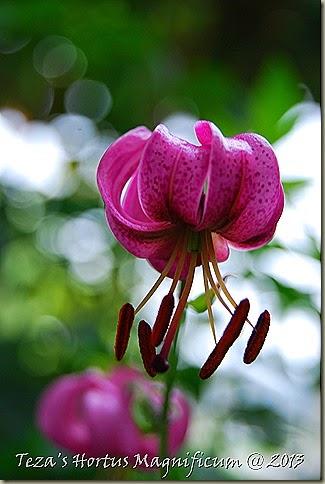I have discovered my next horticultural obsession! Perhaps 'discovered' isn' the proper word, as I have grown Erythronium for a number of years now, but have been limited to two different species in a genus that contains well over one hundred! My first exposure to this exquisite Spring ephemeral came in the darkling woods of Lambton County well over forty years ago, when on Saturday sojourns with my Grandparents, I will thrilled to discover bright yellow flowers that I assumed were lilies of some sort. It was another one of the 'if you want to fully appreciate my beauty' kind of plants, the ones that demand that you prostrate yourself on the ground in order to fully experience their beauty. My garden today is filled with this type of plant, but sadly, not very many Erythronium. The native Erythronium americanum, with its clear, yellow flowers and magnificently mottled green and purplish brown foliage grows in abundance a few short side roads away from where I garden, but I have never seen them available for sale in the local nurseries.
My good friends at Fraser's Thimble Farms on Salt Spring Island, off the coast of British Columbia have perhaps the largest selection of species available in their online catalogue, and it was here that I purchased E.revolutum, E. dens canis, and E.japonicum some years back. None of them are fast spreaders, and as of last year, only the whipped buttery yellow E.japonicum [ I thought I was getting a pink flowering species!] flowers reliably for me. The remainder offer me their sublimely patterned foliage, but no flowers. Methinks I need to get serious about this demure beauty! Having said such, I was thrilled to see that Chris Clennet, in conjunction with Kew Publishing has released, what is said to be the first truly comprehensive monograph on the genus! When you obsess about a specific genus as I do, nothing comes remotely close to the signature Kew Botanical Magazine Monograph. I own one on the genus Cypripedium, and already have my eye set on yet another, this time on perhaps the ultimate Holy Grail genus, Meconopsis. These in depth, academically derived books might appear somewhat daunting upon one's first perusal, but for those who demand all there is to know about a specific genus, with topics ranging from history, phytogeography, morphology, cytology, anatomy, taxonomic treatment, or for those simply interested in the various hybrids, cultivars, and cultivation, you cannot go wrong with this collection. Word to the wise, they do not come cheaply, but based on the plethora of knowledge that each contains, they are definitely a worthwhile investment.
I am still very early on with reading this book, but have already skipped ahead to create a list of species that I hope to add to the garden this year. I should hope to be able to purchase blooming specimens, as I was able to with my previous purchase from Thimble Farms, as it would appear that there is a lot of 'variations' present even within the same species. They remind me of stars that have fallen from the heavens to take up residence in the garden!





































No comments:
Post a Comment